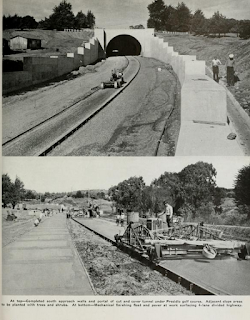California State Route 1 Big Sur Closure Signs
California State Route 1; exploring Point Lobos and Pfeiffer Big Sur State Park
Challenger Coast Range Adventures Part 2; California State Route 1 from Sign County Route G16 to the Nacimiento-Fergusson Road
California State Route 1; the new Pfeiffer Canyon Bridge opens
California State Route 1; prelude to Pfeiffer Canyon Reopening
California State Route 1; Ragged Point Closure south to San Luis Obispo
California State Route 1 the Shoreline Highway Part 2; a drive through Sonoma County
California State Route 1 the Shoreline Highway; a drive through Mendocino County
Paper Highways; California State Route 1 through the Lost Coast
In 1933 the definition of LRN 56 was extended south to LRN 2 (US Route 101) near Las Cruces and north to Ferndale to LRN 1 (also US Route 101) through the Lost Coast region. The August 1934 California Highways and Public Works featured the initial run of Sign State Routes. California State Route 1 was applied to LRN 56 from Las Cruces northward towards Fortuna
The Golden Gate Bridge was completed April 19, 1937 and was ultimately dedicated on May 28. The ceremonies leading up to the opening of the Golden Gate Bridge are discussed in the May 1937 California Highways & Public Works. The article notes the unlike the State built San Francisco-Oakland Bay Bridge construction of the Golden Gate Bridge was financed by the six Counties of San Francisco Bay. Thusly even from the outset the Golden Gate Bridge was never considered to be a State Highway facility. The Golden Gate Bridge features an 8,980-foot-long hybrid truss-suspension design. The Golden Gate Bridge from the outset carried the implied routing of US Route 101 and California State Route 1 despite not being a state-maintained structure.
The March 1940 California Highways & Public Works shows the Park-Presidio Boulevard/Funston Avenue Approach of California State Route 1 in ongoing construction. The article cites the Park-Presidio Boulevard Funston Avenue Approach as having an anticipated completion date of April 15. The 1,300-foot-long tunnel under the Presidio Golf Course is cited as having been completed in January of 1940. Following the opening of Park-Presidio Boulevard the alignment of California State Route 1in San Francisco was complete
The May/June 1957 California Highways & Public Works announced California State Route 1 between Valley Ford and Jenner via Bodega Bay was about to finally become part of LRN 56 on July 1. California State Route 1 between Valley Ford and Jenner was upgraded via Federal Aid Secondary County Route 777 (FAS 777). FAS 777 had been under construction since September of 1951 and included a brand new 8.9-mile road directly linking Valley Ford to Bodega Bay. The inclusion of road between Valley Ford and Jenner closed a gap in State maintenance of California State Route 1.
A story regarding the new Westport-Leggett Spur of LRN 56 is detailed in the May/June 1958 California Highways & Public Works. The Westport-Leggett spur of LRN 56 was indeed ultimately signed as part of California State Route 1 and was part of FAS Route 504. Mendocino County is said to have pushed during the fall of 1955 to have the planned Westport-Leggett Spur of LRN 56 added Federal Aid Secondary system. The article goes onto cite that part of the 1951 legislation that added the Westport-Leggett Spur of LRN 56 was that the State would not have to maintain the roadway until it was brought up to Division of Highways standards. Maintenance of the Westport-Leggett Spur of LRN 56 began on July 1, 1957.
During the 1964 State Highway Renumbering the Legislative Route Numbers were dropped. What had been the spur of LRN 56 to Leggett was renumbered to California State Route 208. California State Route 1 remained planned through the Lost Coast to Ferndale. These changes can be seen on the 1964 Division of Highways State Map.
California State Route 1was spun off onto its own alignment away from US Route 101 on the Rincon Seawall as part of 1980 Legislative Chapter 740. This new standalone segment of California State Route 1 on the Rincon Seawall was created after US Route 101 had been moved uphill above the Union Pacific Railroad onto a freeway grade.
During 1984 the unbuilt California State Route 1 in the Lost Coast and from Ferndale to Fortuna was transferred California State Route 211 via Legislative Chapter 489. Legislative Chapter 489 also transferred California State Route 1 over what had been California State Route 208. The changes described above first appear on the 1986 Caltrans State Highway Map.




































Comments